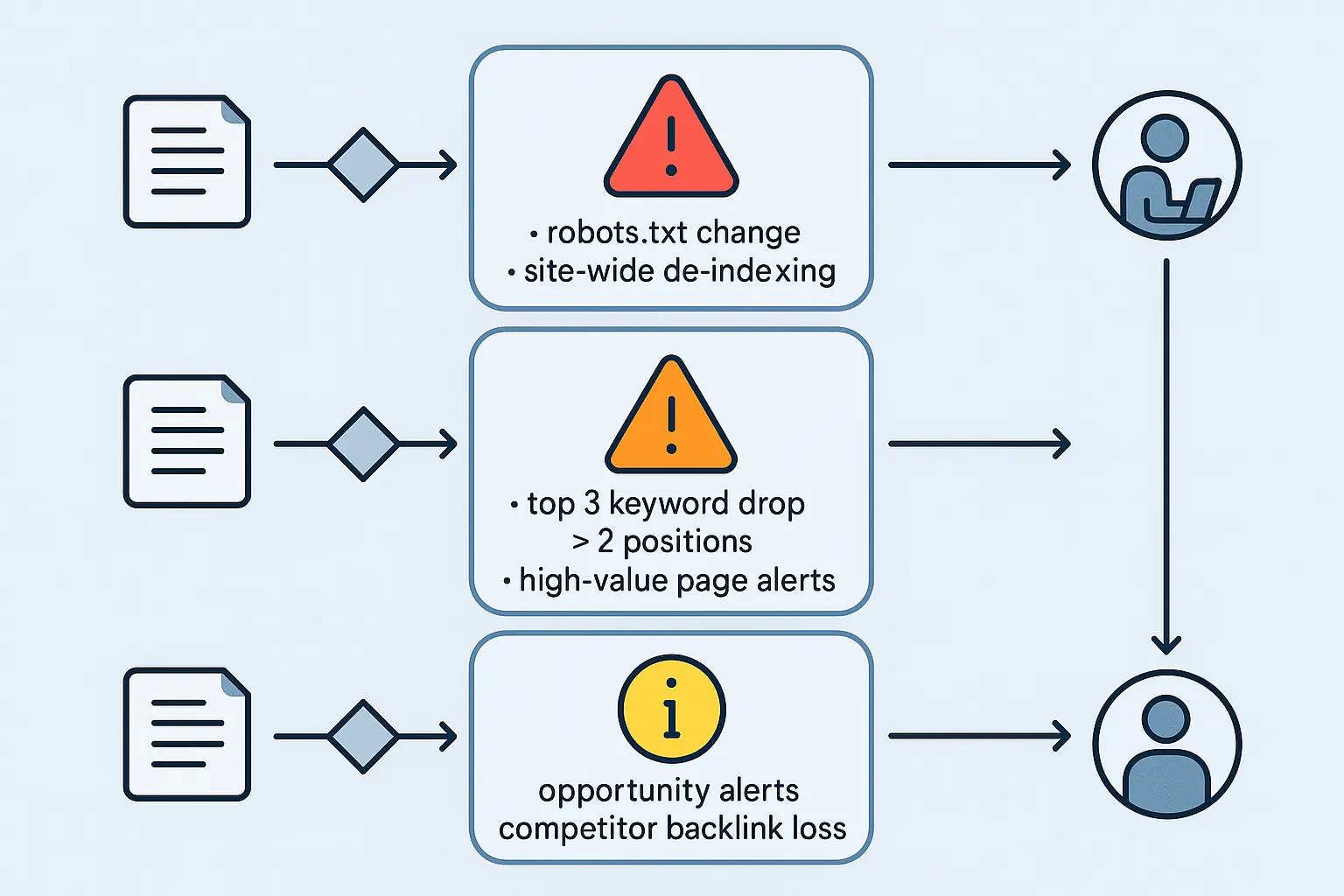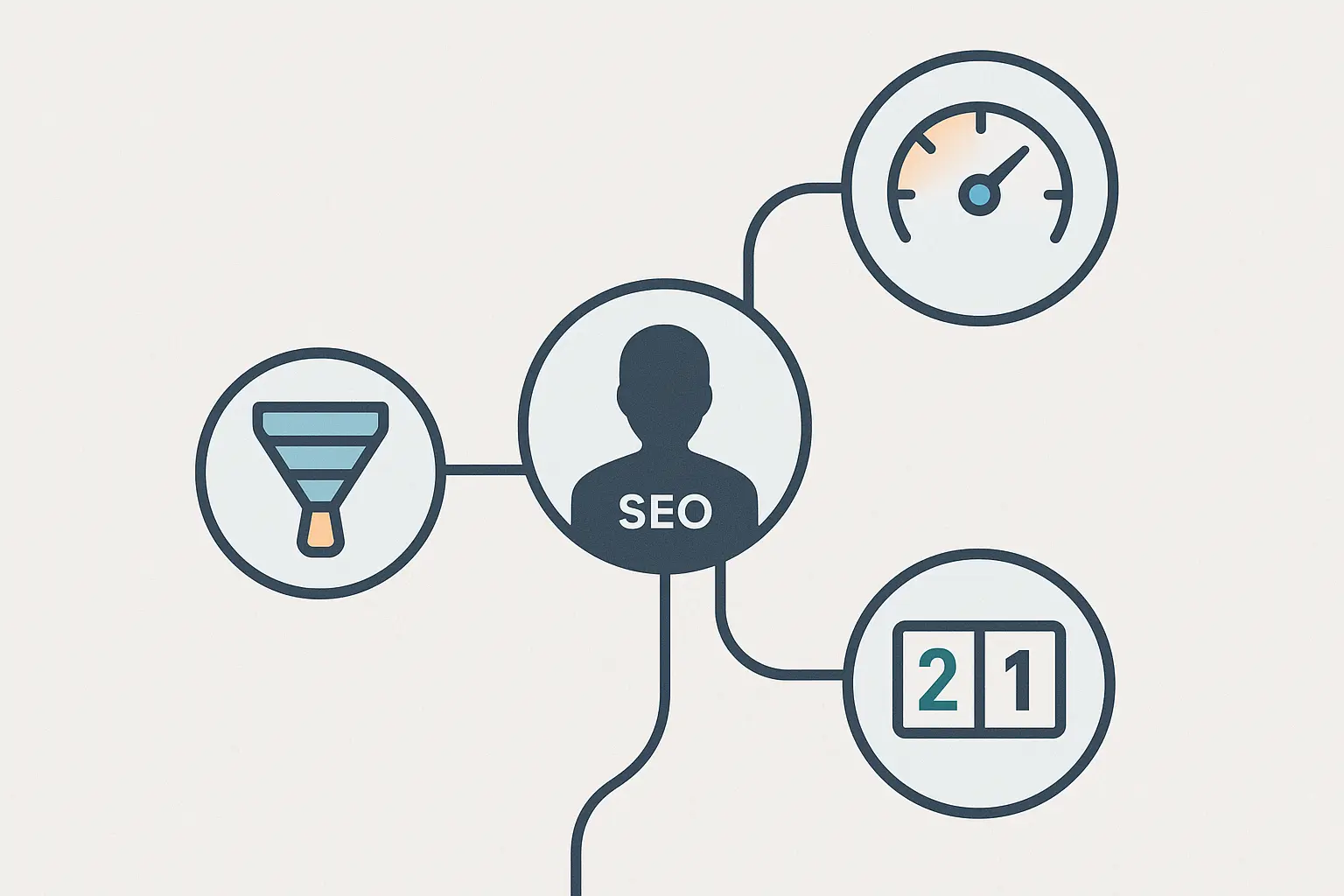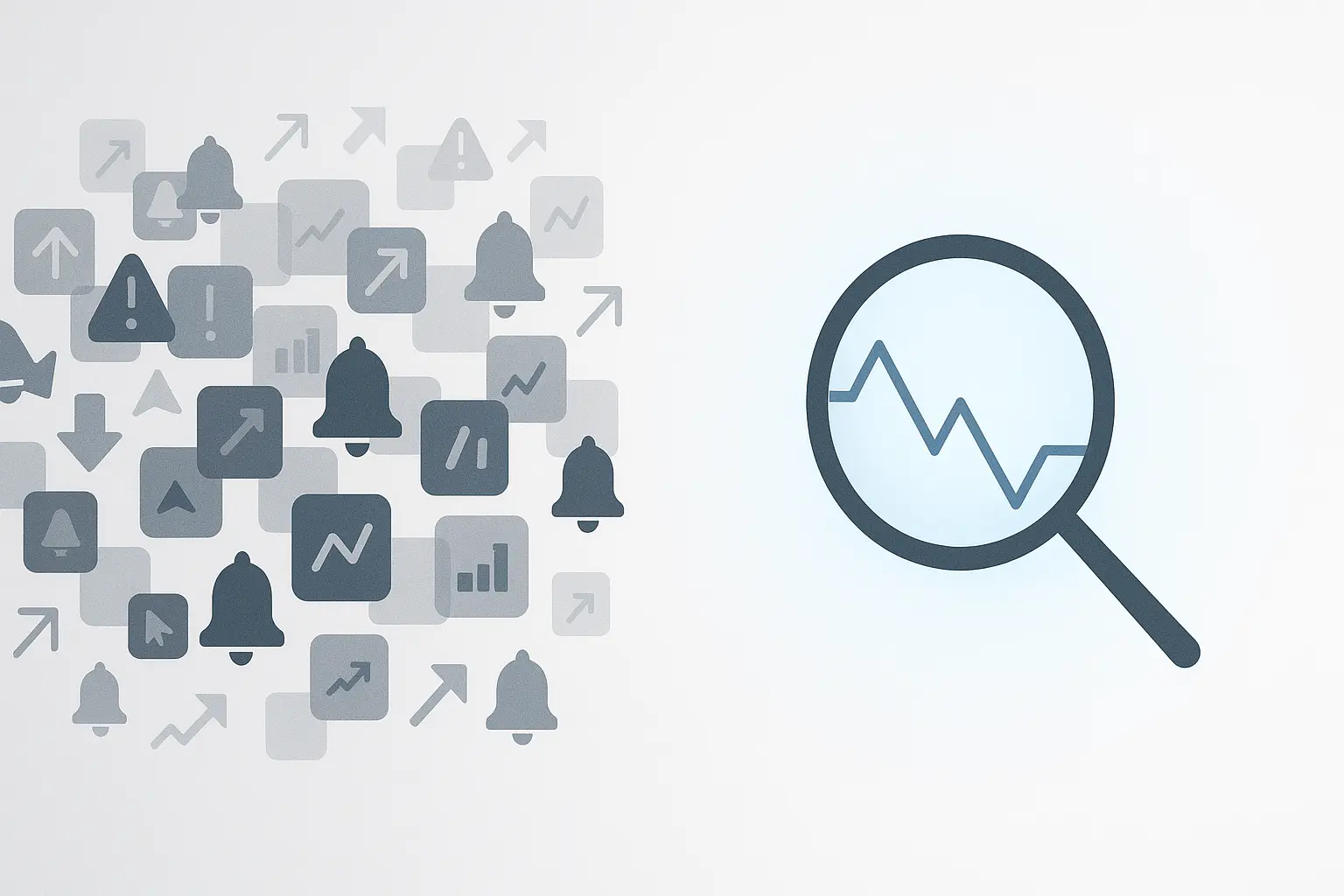You open your inbox on a Monday morning. It’s already flooded. Among the client emails and team updates, a stream of automated notifications from your SEO tools flows in: “Keyword position changed,” “New backlink detected,” “Crawl completed: 3,408 issues found.”
Your eyes glaze over. Are any of these notifications actually important? Is there a fire to put out, or is it all just… noise?
This feeling—“alert fatigue”—is one of the biggest paradoxes of modern SEO. We have access to more data than ever, but that access has created its own problem. As a Forrester report highlights, 67% of marketers now say they’re overwhelmed by the amount of data they collect. We’re drowning in information but starving for insight. The solution isn’t more data; it’s better signals.
A “human-in-the-loop” system, powered by smart intervention triggers, transforms an overwhelming firehose of data into a precise, actionable alert system.
What is a Human-in-the-Loop System in SEO?
Think of it like a skilled pilot using autopilot. The automation handles the cruising—monitoring thousands of data points, running crawls, and tracking competitors 24/7. The human expert, the pilot, doesn’t need to manually steer the plane every second. Instead, the system is designed to alert them only when specific, critical conditions are met—moments that require their expertise to navigate turbulence or make a perfect landing.
An intervention trigger is simply a rule you create that tells the autopilot: “This specific event is important enough to require my attention now.” It’s a partnership where automation handles scale and vigilance, freeing up human intelligence for strategy and critical thinking. As Gartner predicts, AI is set to augment human roles, not replace them, by creating $2.9 trillion in business value. In SEO, that augmentation starts with defining when and why a human needs to step in.
The Problem with Default Alerts: Drowning in Data
Most SEO tools come with default alert settings designed to show you everything the tool can do. While well-intentioned, this creates a chaotic workflow where critical signals are buried under a mountain of low-impact notifications.
You get an alert when a keyword moves from position 8 to 9 (noise), and you get another when it drops from position 2 to 11 (a crisis). In a cluttered inbox, both look the same.
This constant stream of low-value information means you spend your time sifting through data instead of acting on it. You become reactive, constantly checking if something is wrong rather than proactively executing a growth strategy. The real risk? You start ignoring all alerts, and a genuine emergency slips through the cracks.
Introducing Intervention Triggers: Your Signal in the Noise
An intervention trigger is a custom threshold you define that escalates an issue from the automated system to a human expert. Instead of a generic alert, it’s a specific, context-rich command for action.
Generic Alert: “Keyword rank changed.”
Intervention Trigger: “Notify a human if a top-3 keyword on the ‘Services’ page drops more than two positions in 24 hours.”
See the difference? The first is data. The second is an instruction rooted in business value. By setting these custom thresholds, you transform your tools from noisy notification centers into a disciplined early-warning system. This frees up your team to focus their valuable time on tasks that require human creativity, strategy, and client communication—precisely the high-value work McKinsey found automation helps unlock.
How to Set Practical Intervention Triggers: Real-World Examples
Effective triggers are tied directly to business impact. A rank drop for a blog post is not the same as a drop for a primary commercial keyword. Here’s how to set up smart, surgical triggers across key areas of SEO.
1. Keyword Ranking & Visibility Triggers
Daily fluctuations are normal; catastrophic drops are not. Your triggers should know the difference.
Protect High-Value Assets:
Trigger: If a keyword in our “Top 5 Commercial Intent” segment drops out of the top 3, create a high-priority task for the account strategist.
Why it’s smart: It ignores minor fluctuations for less important keywords and focuses attention on what directly impacts leads and revenue.
Detect Major Algorithm or Technical Issues:
Trigger: If a page loses more than 50% of its tracked keywords in a week, send an urgent alert to the technical SEO lead.
Why it’s smart: This isn’t normal fluctuation. This points to a potential de-indexing, manual penalty, or major crawl issue.
Monitor Competitive Threats:
Trigger: If a new competitor enters the top 5 for a primary money keyword, flag for monthly strategy review.
Why it’s smart: It’s not an emergency, but it’s crucial strategic intelligence that should inform your ongoing content and link-building efforts.
2. Backlink Profile Triggers
Manually reviewing every new link is impossible. Triggers help you focus on the links that can either help you the most or hurt you the most.
Prevent Link-Based Penalties:
Trigger: If a new backlink is acquired from a domain with a toxicity score above 7, add it to a “Disavow Review” list.
Why it’s smart: It proactively catches potentially harmful links from negative SEO attacks or low-quality directories before they become a problem.
Protect Your Best Links:
Trigger: If a backlink from a domain with a Domain Rating (DR) of 70+ is lost, create a task for link reclamation outreach.
Why it’s smart: High-authority links are hard-won assets. This trigger ensures you never lose one without a fight. This is a core part of an advanced link building strategy (https://www.jvglabs.com/services/link-building-services-for-agencies).
3. Technical & On-Page SEO Triggers
A site crawl can produce a report with thousands of “issues.” Most are minor suggestions; a few are site-breaking emergencies. Your triggers should separate the trivial from the terminal.
Guard Critical Site Files:
Trigger: If the robots.txt file is modified in any way, send an immediate, high-priority alert to the head of SEO.
Why it’s smart: An accidental “Disallow: /” in this file can remove an entire site from Google. This is a five-alarm fire that requires immediate human intervention.
Lock Down Core On-Page Elements:
Trigger: If the title tag, H1, or meta description of the homepage or a primary service page is changed, notify the account manager.
Why it’s smart: This prevents unauthorized or accidental changes by clients or developers that could tank the rankings of your most important pages. Completing a technical SEO audit (https://www.jvglabs.com/blog/how-to-do-a-technical-seo-audit) helps establish these baselines.
Monitor Core Web Vitals:
Trigger: If the LCP, FID, or CLS score for a key user journey page (e.g., checkout, contact form) drops into the “Poor” category, create a ticket for the web development team.
Why it’s smart: It connects a technical metric directly to user experience and conversion, ensuring performance issues on critical pages get fixed quickly.

The Benefits of a Trigger-Based Approach
Adopting a trigger-based approach delivers immediate, tangible benefits for any agency.
-
Radical Efficiency: Your team stops wasting time on false alarms and focuses its expertise on genuine strategic challenges and opportunities.
-
Proactive Problem-Solving: You spot fires when they are still embers, often fixing major issues long before a client even notices their rankings have slipped.
-
Improved Scalability: An intelligent, scalable monitoring system allows an agency to confidently take on more clients without a linear increase in headcount. This is the operational backbone of successful white label SEO (https://www.jvglabs.com/services/white-label-seo) partnerships.
-
Demonstrable Value: Instead of sending clients massive data dumps, you can report on the specific, high-impact interventions your team made, clearly demonstrating your strategic value.

Comprehensive FAQ Section
What’s the difference between an alert and an intervention trigger?
An alert is raw information (e.g., “data changed”). An intervention trigger is a rule that escalates that information based on its strategic importance, creating a call to action for a human expert.
How do I know what thresholds to set?
Start with your most important assets. For a client, what are the top 5 keywords they absolutely cannot afford to lose? What are the 3 pages that drive the most conversions? Build your first triggers around protecting them. You can adjust the sensitivity over time.
Won’t I miss important things if I filter my alerts?
Quite the opposite. You’re more likely to miss something important when it’s buried in a sea of noise. A trigger-based system ensures that the truly critical alerts are the only ones you see, making them impossible to miss.
Can I set this up with common SEO tools?
Yes. Most major SEO platforms (like Ahrefs, Semrush, and Moz) offer custom alert and reporting features. You can often configure them to send notifications only when certain conditions are met, or you can use third-party integration tools like Zapier to build more complex workflows.
Is this only for large agencies?
No! In fact, this approach is even more valuable for freelancers and small agencies. When time is your most limited resource, focusing it exclusively on high-impact tasks is the key to profitability and growth.

Your Next Step: From Data Overload to Strategic Action
Stop letting your tools dictate your workflow. It’s time to design an intelligent system where automation serves your strategy, not the other way around.
You don’t have to rebuild your entire process overnight. Start small: pick one client and one area—like keyword rankings—and ask yourself, “What are the 3-5 events that would absolutely require my immediate attention?” Then, go into your tools and build those specific triggers.
By consciously deciding when your expertise is needed, you’ll move from being a reactive data janitor to a proactive, strategic leader—the invaluable partner your clients need.

